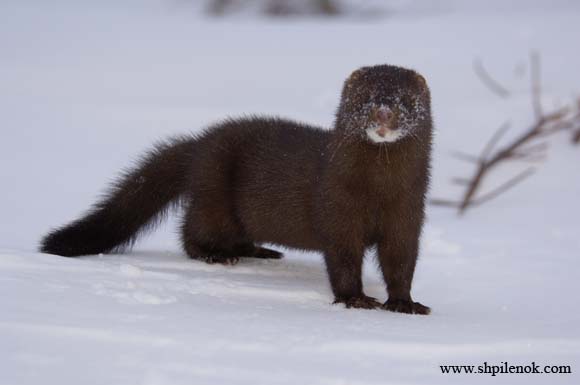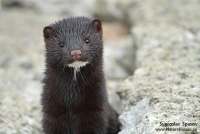The mink can be found living along rivers, lakes, wetlands and forests in the entire state of Wisconsin. They are m ore aquatic than most other weasels and often dig their burrows with an entrance on the water's edge. Mink are excellent swimmers and will travel underwater up to 100 feet in distance and 15 feet deep in search of food. These fearless carnivores have voracious appetites and eat a diet composed of small to medium mammals, fish, crayfish, and water fowl such as ducks. In the winter they eat mostly muskrat, sometimes even attacking while the muskrat is swimming.
ore aquatic than most other weasels and often dig their burrows with an entrance on the water's edge. Mink are excellent swimmers and will travel underwater up to 100 feet in distance and 15 feet deep in search of food. These fearless carnivores have voracious appetites and eat a diet composed of small to medium mammals, fish, crayfish, and water fowl such as ducks. In the winter they eat mostly muskrat, sometimes even attacking while the muskrat is swimming.
Females mate in the winter and give birth in the early spring to 4-9 kits. The young are fully weaned by 7 weeks, self-sufficient by 8 weeks and sexually mature by 10 months. Young are occasionally killed by coyotes, great horned owls, and other large carnivores. However, the only real threat to mink are humans that hunt mink for their prized pelts.
Fun Facts
- Mink have a lifespan of 5-10 years.
- Like many other weasels, the mink releases an incredibly foul-smelling musk when threatened and marks its territory with a pungent excretion.
- A male mink's territory can be up to 40 acres in size. The female's is about half the size and often overlaps males.
 The mink waterproofs its fur with an oily substance which provides excellent insulation in near freezing waters.
The mink waterproofs its fur with an oily substance which provides excellent insulation in near freezing waters.- This common weasel is also commonly called the American Mink.
- Mink are susceptible to bioaccumulation of mercury and other heavy metals and toxins. This poses a dangerous threat to the survival and reproduction of some mink.
- Mink are invasive in parts of Europe where they were introduced by mink farmers.
*Information cited in this article was gathered with the help of The Mammals of the Great Lakes Region by Allen Kurta and Mammals of Wisconsin by Stan Tekiela.





